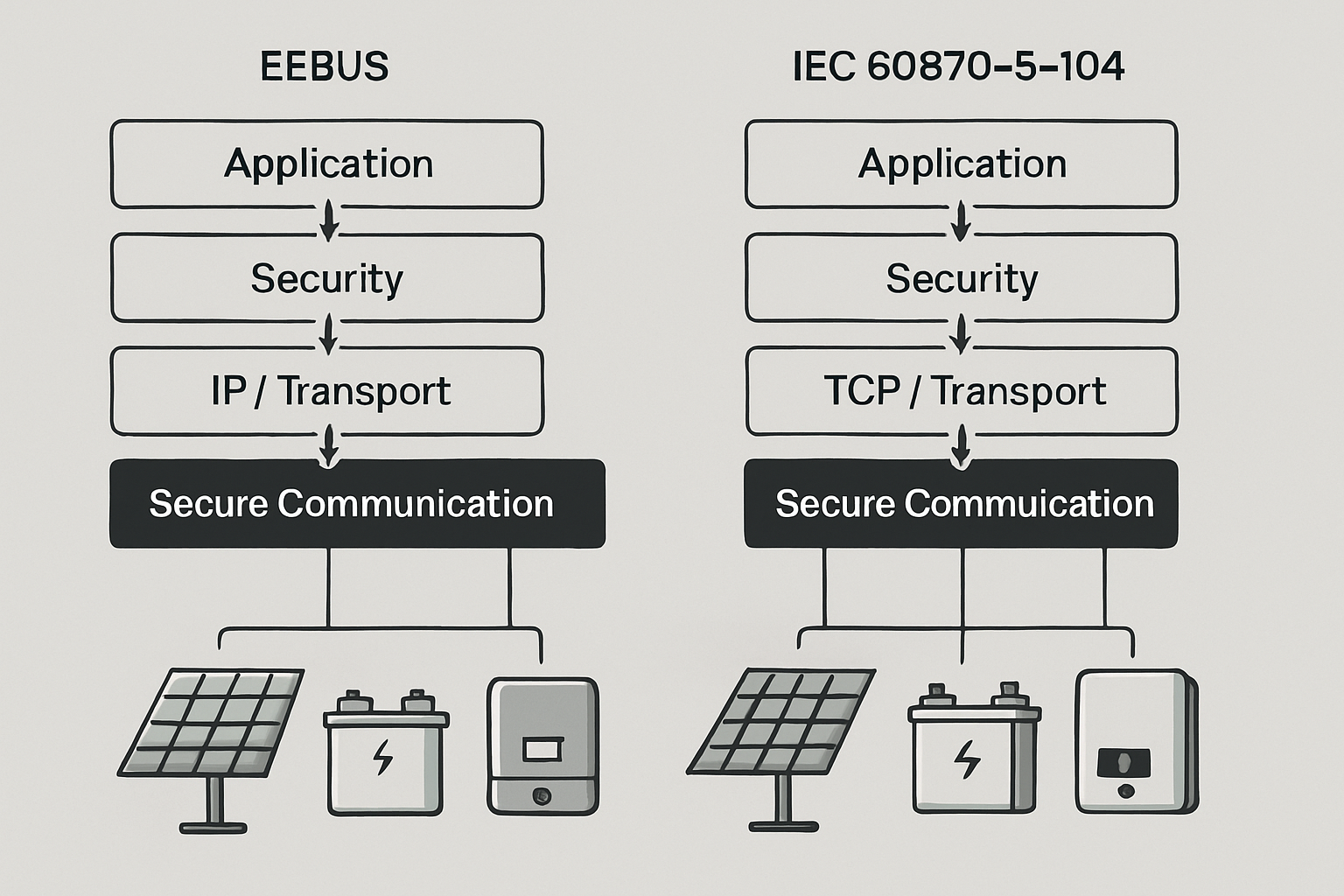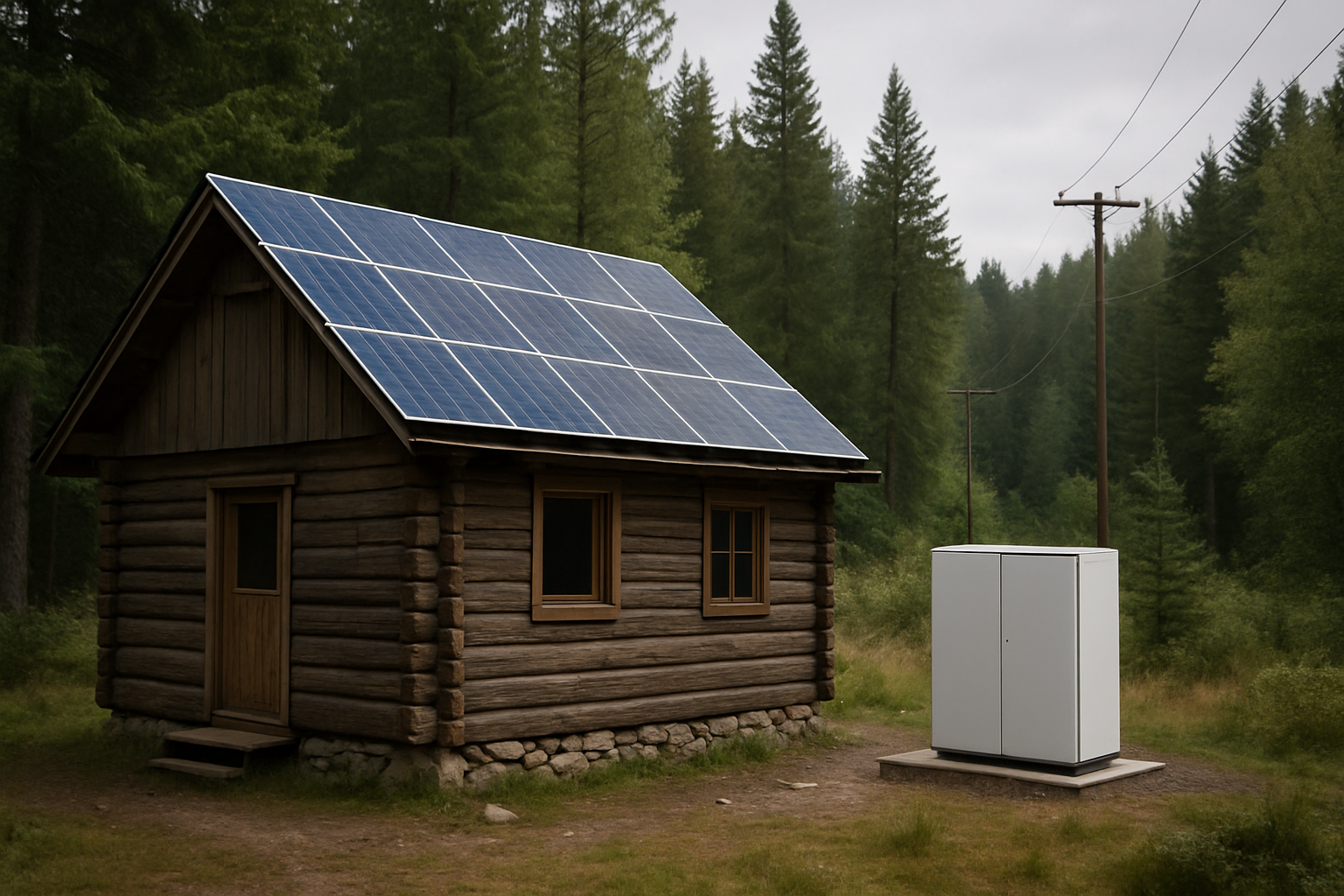Remote control of distributed energy resources (DER) has transformed from a luxury to a necessity. With over 25 GW of distributed solar capacity added globally in 2024, system operators need standardized protocols to manage these assets securely and efficiently. Two standards stand at the forefront of this evolution: IEEE 1547 and IEC 60870-5-104.
These protocols don't just enable communication—they establish the foundation for secure, interoperable DER control that protects both grid stability and energy assets. Understanding their implementation can mean the difference between a vulnerable system and a resilient energy infrastructure.

IEEE 1547: The Foundation of DER Interoperability
IEEE 1547-2018 establishes the technical requirements for connecting DER to the electric power system. Unlike its predecessor, the current standard mandates that all conformant DER respond to local and remote control signals limiting active power, regardless of system size.
Core Communication Requirements
The standard requires DER to implement at least one of three protocols:
- SEP2 (IEEE Std 2030.5): Smart Energy Profile for demand response
- DNP3 (IEEE Std 1815): Distributed Network Protocol for SCADA systems
- SunSpec Modbus: Over Ethernet or RS-485 for solar applications
According to IRENA's Grid Codes for Renewable Powered Systems, this flexibility allows system operators to maintain existing communication infrastructure while ensuring new DER can integrate seamlessly.
Active Power Control Mechanisms
Remote control capabilities extend beyond simple on/off switching. IEEE 1547 defines sophisticated control functions including:
| Control Function | Response Time | Application |
|---|---|---|
| Frequency Response | 1-10 seconds | Grid frequency regulation |
| Voltage Regulation | 10-60 seconds | Local voltage support |
| Active Power Curtailment | 5-300 seconds | Grid congestion management |
| Reactive Power Control | 1-5 seconds | Power factor correction |
These controls enable DER to participate in grid services previously reserved for conventional power plants. In Germany, for example, remote control requirements apply to all DER above 25 kW, with full financial compensation for curtailed energy ensuring continued investment incentives.
IEC 60870-5-104: Secure SCADA Communication
IEC 60870-5-104 extends the IEC 60870-5-101 protocol for TCP/IP networks, enabling secure remote monitoring and control over public networks. This standard has become crucial as DER installations increasingly rely on internet-based communication.
Protocol Architecture and Security
The protocol implements multiple security layers:
- Application Layer Security: Authentication and authorization mechanisms
- Transport Layer Protection: TLS encryption for data in transit
- Network Layer Controls: IP filtering and access control lists
- Physical Layer Security: Secure communication channels
In China, the adapted standards DL/T 634.5.101 and DL/T 634.5.104 mandate these security measures for all DER connected at medium voltage levels. IRENA research indicates that information security protection measures are mandatory for low voltage DER using wireless or optical fiber public networks.
Real-Time Data Exchange
IEC 60870-5-104 supports various data types essential for DER control:
| Data Type | Update Rate | Typical Use |
|---|---|---|
| Single Point Information | Event-driven | Breaker status, alarms |
| Measured Values | 1-60 seconds | Power output, voltage levels |
| Integrated Totals | 15-60 minutes | Energy production, consumption |
| Commands | Real-time | Start/stop, setpoint changes |
Cybersecurity Implementation Strategies
The shift to internet-based communication has made cybersecurity critical for power system security. Industry analysis shows that cybersecurity has become one of the most critical factors for electricity supply security and will only grow in importance.
Multi-Layer Defense Architecture
Effective cybersecurity requires implementing multiple defense layers:
- Perimeter Security: Firewalls and intrusion detection systems
- Device Authentication: Certificate-based device identity verification
- Data Encryption: End-to-end encryption for all communications
- Access Control: Role-based permissions and time-limited access
- Monitoring and Logging: Real-time threat detection and audit trails
Compliance and Risk Management
Organizations must address regulatory requirements while managing operational risks. Key considerations include:
- Regular security assessments and penetration testing
- Incident response procedures and recovery planning
- Staff training on cybersecurity best practices
- Vendor security requirements and supply chain protection
The challenge intensifies as DER installations scale. Each additional device represents a potential attack vector, making standardized security protocols essential for system-wide protection.
Practical Implementation Challenges
Real-world deployment of IEEE 1547 and IEC 60870-5-104 presents several challenges that system integrators must navigate carefully.
Interoperability Across Vendors
While standards exist, vendor implementations often include proprietary extensions that can complicate integration. Common issues include:
- Different interpretation of optional protocol features
- Varying response times to control commands
- Inconsistent alarm and event reporting
- Proprietary security implementations
Testing and validation become crucial. Each DER installation should undergo comprehensive interoperability testing before commissioning to ensure reliable operation under all conditions.
Scalability and Performance
As DER penetration increases, communication systems must handle growing data volumes without compromising response times. Key performance metrics include:
| Metric | Target Value | Impact of Deviation |
|---|---|---|
| Command Response Time | < 2 seconds | Delayed grid response |
| Data Update Rate | 1-5 seconds | Reduced situational awareness |
| Communication Availability | > 99.5% | Loss of remote control |
| Cybersecurity Response | < 1 second | Potential system compromise |
Future-Proofing DER Communication Systems
The evolution of DER control standards continues as grid requirements become more sophisticated. Emerging trends include artificial intelligence integration, edge computing capabilities, and enhanced cybersecurity measures.
Integration with Advanced Grid Technologies
Next-generation DER control systems must support:
- Predictive Analytics: Machine learning algorithms for optimized dispatch
- Edge Processing: Local decision-making to reduce latency
- Blockchain Integration: Secure, decentralized transaction recording
- 5G Communication: Ultra-low latency for real-time control
These technologies promise to enhance both performance and security while enabling new grid services and revenue streams for DER owners.
Regulatory Evolution
Standards organizations continue refining requirements based on operational experience. The IEA's Power of Transformation report emphasizes that enhanced measurement and forecasting of variable generation output is essential for bulk power system reliability.
Future standards will likely mandate more sophisticated forecasting capabilities, improved cybersecurity measures, and enhanced interoperability requirements as DER penetration reaches critical levels.
Building Resilient DER Control Infrastructure
Success in implementing IEEE 1547 and IEC 60870-5-104 requires a systematic approach that balances technical requirements with practical constraints. The key lies in understanding that these standards are not just technical specifications—they're the foundation for a secure, efficient energy future.
Organizations that invest in proper implementation today will find themselves better positioned for tomorrow's grid challenges. The standards provide the framework, but successful deployment requires careful planning, thorough testing, and ongoing vigilance against evolving threats.
As distributed energy resources continue their rapid expansion, mastering these communication protocols becomes essential for anyone serious about participating in the modern energy ecosystem. The complexity is real, but so are the opportunities for those who get it right.
References
- IRENA (2022). Grid Codes for Renewable Powered Systems
- IEA (2014). The Power of Transformation
- IEEE Standards Association (2018). IEEE 1547-2018 - IEEE Standard for Interconnection and Interoperability of Distributed Energy Resources
- IEC 60870-5-104: Network access for IEC 60870-5-101 using standard transport profiles





Leave a comment
All comments are moderated before being published.
This site is protected by hCaptcha and the hCaptcha Privacy Policy and Terms of Service apply.